Giochi dell'Oca e di percorso
(by Luigi Ciompi & Adrian Seville)
(by Luigi Ciompi & Adrian Seville)

|
Giochi dell'Oca e di percorso
(by Luigi Ciompi & Adrian Seville) |

|
 |

Torna alla ricerca giochi (back to game search) |
 |
| Declaration (Joc de la Oca) | ||
 |
Versione stampabile
 |
Invia una segnalazione

|
 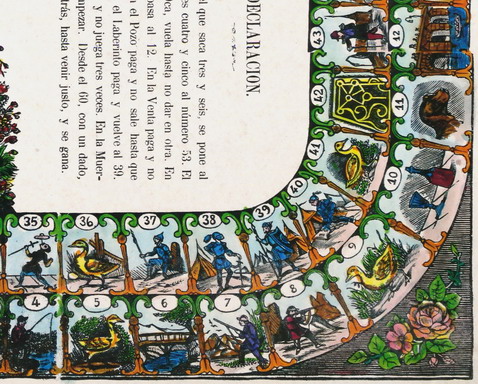 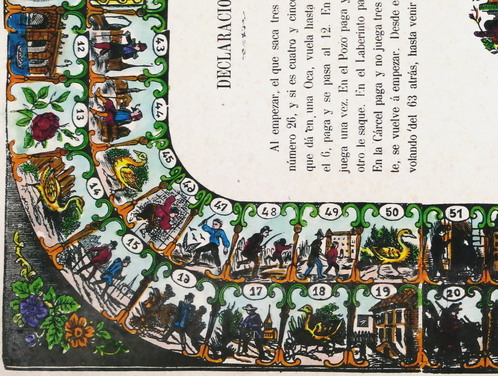  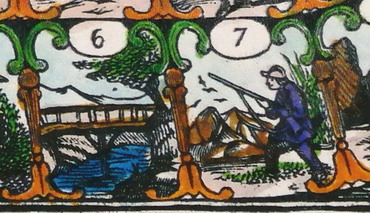  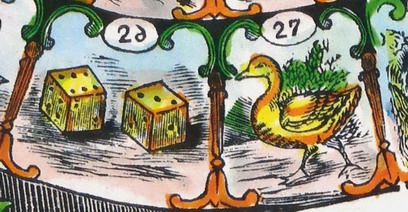 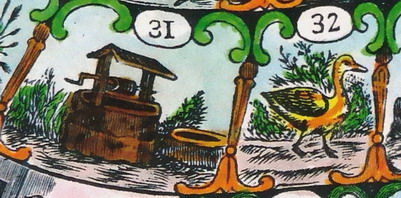 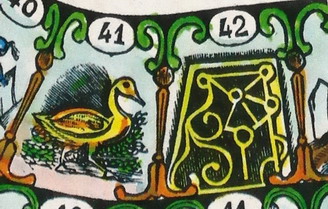  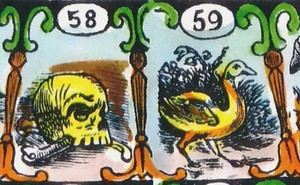 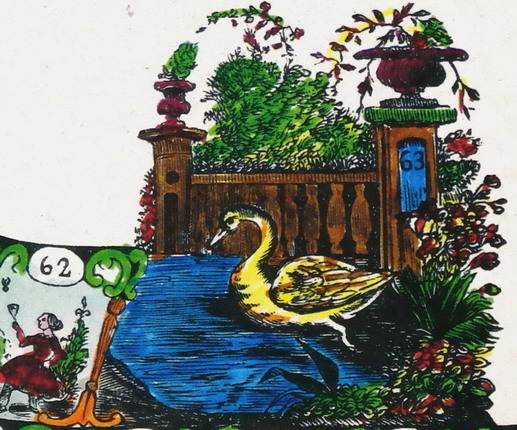  |
primo autore: | Anonimo |
| secondo autore: | Réus | |
| anno: | 1850ca | |
| luogo: |
Spagna-Barcellona |
|
| periodo: | XIX secolo (2°-3°/4) | |
| percorso: | Percorso di 63 caselle numerate | |
| materiale: | carta (paper) (papier) | |
| dimensioni: | 441X322 (370X275) | |
| stampa: | Stampa su legno colorata in maschera (bois gravé) (woodcut) | |
| luogo acquisto: | ||
| data acquisto: | ||
| dimensioni confezione: | ||
| numero caselle: | 63 | |
| categoria: | Oca | |
| tipo di gioco: | Gioco Oca Classico (63 caselle) Verticale | |
| editore: | Establecimiento de Juan B. Vidal arrabal alto de Jesus num.5 | |
| stampatore: | Establecimiento de Juan B. Vidal arrabal alto de Jesus num.5 | |
| proprietario: | Collezione A. Seville | |
| autore delle foto: | A. Seville | |
| numero di catalogo: | 1071 | |
| descrizione: |
Gioco di 63 caselle numerate, spirale, antiorario, centripeto, che segue le regole classiche del gioco dell'oca. Il gioco che presenta tutte le caselle illustrate fu stampato dal maggiore editore e tipografo della città catalana di Reus, Juan Baptista Vidal. REGOLE: al centro. "Al empezar, el que saca tres y seis, se pone al numero 26, y si es cuatro y cinco al numero 53. El que dà en una Oca vuela hasta no dar en otra. En el 6 paga y se pasa al 12. En la Venta paga y no juega una vez. En el Pozo paga y no sale hasta que otro le saque. En el Laberinto paga y vuelve al 39. En el Carcél paga y no juega tres veces. En la Muerte, se vuelve à empezar. Desde el 60, con un dado, volando del 63 atràs, hasta venir justo, y se gana." CASELLE: mute. REFERENZA 1 Game 7: Game of the Goose. [Joc de la Oca]. Reus, Catalonia, Spain: Juan B(autista) Vidal [mid-19th c., later reprint]. Hand-colored woodcut, 37 x 27.5 cm. Refs.: Amades, pl. V ; Ciompi/Seville 1071. There is an intriguing record that Francesco de’ Medici (1541- 87) sent the Game of the Goose as a present to Philip II of Spain (1527- 98) (see introductory essay on the history of the game). Although no 16th-century Spanish example of the classic game is known, 17th-century Spanish examples of the classic form do exist. This mid-19th-century game is also of classic form, though (as frequently occurs in Spanish Goose games) the rule for finishing differs from the reverse overthrow rule of the Italian and French models. In the latter, from space 60, a single dice is to be used until an exact finish is reached, with the player staying put if the winning space is overthrown. This leads to a much less exciting game. This Catalonian game is the earliest known Spanish Goose game to be decorated with images unrelated to playing requirements. Vidal has been described as an imaginero, i.e., a publisher of prints with pictures, though he also published books and pamphlets. (Adrian Seville) REFERENZA 2 The earliest exception is noted by Amades as a mid-19th-century print by Juan B(aptista) Vidal (1815-1899) of Reus. The track decorations show figures undertaking a remarkably-wide range of human activities: fishing, hunting with the rifle, walking in the countryside, a soldier marching with his rifle, playing cards and playing dice, harvesting, juggling and acrobatics, girls playing games (skipping, shuttlecock), a knight in armour, tending the vines, bird scaring, kneeling in church, etc. The rules are given in letterpress in the centre: interestingly, although there is a decanter and glass at space 10, the rules do not refer to it: perhaps it was allowed as a drink hazard only by agreement among the players. A dog's head at space 11 is similarly not explained. However, the general decorative scheme indeed suggests a pubblication intended for young people: in one corner of the sheet, a boy and a girl are shown playing the Game of the Goose. (Adrian Seville) Exhibitions: - "The Royal Game of the Goose four hundred years of printed Board Games". Exhibition at the Grolier Club, February 23 - May 14, 2016 (Prof. Adrian Seville). - "Oche, civette e dadi". La Collezione dei Giochi della Biblioteca Classense. Esposizione dal 20/12/2019 al 02/02/2020 a cura di Daniela Poggiali. Istituzione Biblioteca Classense RAVENNA - Comune di Ravenna. |
|
| bibliografia: |
1) BARLETTA, Gabriele: "Sermones fratris Gabrielis Barelete tam quadrigesimales, quam de sanctis noviter impressi." (pubblicati per la prima volta a Brescia da Giacomo Britannico l'11 nov. 1497 i quadragesimali ed il 13 gennaio 1498 gli altri.) Impressi Lugdunum per Magistrum Nicolaum Lupi, 1507. 2) CARRERA, P. : "Il Gioco degli Scacchi", Militello, page 25, 1617. 3) BROWNE, Sir Thomas: "Pseudodoxia Epidemica, ChXII", 1650. 4) LA MARINIERE, de: "La Maison Academique: contenant un recueil general de tous les jeux divertissans pour se rejouyr agreablement dans les bonnes compagnies", par le sieur D.L.M. [de La Marinière]. A Paris: chez Robert de Nain et Marin Leché, M.DC.LIV (1654) 5) MENESTRIER, C. F. : "Bibliotheque Curieuse et Instructive", Trevoux, page 196, 1704. 6) D’ALEMBERT et Alii: "Encyclpédie Methodique: Mathematiques" (con "Dictionnaire de Jeux, faisant suite au Tome III des mathématiques") Ed. Panckoucke e Agasse, Parigi 1792. 7) VINCK, Eugène, Baron de: "Iconographie du Noble Jeu de l’Oye. Catalogue descriptif et raisonné de la Collection de Jeux formé par le Baron de Vinck". 126 Jeux du XVIIIe au débùt du XIXe siècle. FR. J. Olivier Libraire, 11 Rue des Paroissiens, Bruxelles, 1886. 8) CULIN, S. : "Chess and Playing Cards", University of Pennsylvania, pages 843-848, 1895. 9) GRAND-CARTERET, John: "Les jeux d'oie". In "Vieux papiers, vieilles images. Cartons d’un Collectionneur", Le Vasseur&C.ie Parigi (pp. 257-276), 1896- 10) BLAU, J.L. : "The Christian Interpretation of the Cabala in the Renaissance", Columbia University Press,1944. 11) D’ALLEMAGNE,H. R. : "Le Noble Jeu de l’Oie", Paris, Libraire Gruend, 1950. 12) AMADES, Joan: "El Juego de la Oca", Bibliofilia Vol.III, Editorial Castalia, Valencia, 1950. 13) WHITEHAUSE, F. R. B. : "Table Games of Georgian and Victorian Days", London, Peter Garnett, 1951. 14) MURRAY H. J. R. : "A History of Board Games Other Than Chess", Oxford University Press, pp 142-143, 1952. 15) NEGRI, Ilio – VERCELLONI, Virgilio: "I giochi di dadi d’azzardo e di passatempo dei gentiluomini e dei pirati". Introduzione di Caterina Santoro, Lerici Milano (Contiene 125 giochi).1958 16) HANNAS, L. : "The English Jigsaw Puzzle", London, Wayland, page 115, 1972. 17) HIMMELHEBER, G. : "Spiele – Gesellschaftspiele aus einem Jahrtausend", Deutscher Kunstverlag, 1972. 18) Catalogo Mostra: "Il dilettevole giuoco dell’oca". Museo Civico Lodi (catalogo redatto da Silvia Mascheroni e Bianca Tinti), 1980. 19) MASCHERONI S. and TINTI, B. : "Il Gioco dell'Oca", Milano, Bompiani, 1981. 20) GIRARD A. R. - QUETEL, C. : "L'histoire de France racontée par le jeu de l'oie", Paris, Balland/Massin, 1982. 21) MILANO, Alberto: "Antichi giochi su carta". In "Come giocavamo. Giochi e giocattoli 1750-1960". Bonato Patrizia - Franzini Paolo - Tosa Marco (curatori della mostra), 1984. 22) VON WILCKENS, L. : "Spiel, Spiele, Kinderspiel (exhibition catalogue)", Germanisches Nationalmuseums, Nuernberg, page 17, 1985. 23) PREAUD, M. - CASSELLE, P. - GRIVEL, M. - LE BITOURE' C.: "Dictionnaire des éditeurs d'estampes à Paris sous l'Ancien Régime". Promodis,1987. 24) HUFMANN C.C. :"Elizabethan Impressions: John Wolfe and His Press", New York, AMS Press; 1988. 25) DEPAULIS, Thierry: "Sur la piste du jeu de l’oie". In "Le Vieux Papier", fascicolo n°345, ottobre 1997, Parigi. 26) DOMINI, D. : (in)"La Vite e il Vino" (exhibition catalogue), Fondazione Lungarotti, pages 37-38, 1999. 27) DEPAULIS, Thierry: "Sur la piste du jeu de l’oie II". In "Le Vieux Papier", fascicolo n°352, (pag. 269-270) aprile 1999, Parigi. 28) Catalogo Mostra: “Le jeu de l’oie au musée du jouet”, Ville de Poissy 2000. 29) Catalogo Mostra: "Il Gioco dell’oca nei tempi", Pro Loco Mirano, Ed. CentroOffset srl - Mestrino, Padova 2001- 30) ZOLLINGER, M. : "Zwei Unbekannte Regeln des Gansespiels", Board Game Studies 6, Leiden University, 2003. 31) SEVILLE, Adrian:"Tradition and Variation in the Game of Goose", in: "Board Games in Academia III", Firenze, Aprile 1999. (aggiornamento del 2005). 32) BUIJNSTERS, P.J. and Buijnsters-Smets,L. : "Papertoys", Zwolle, Waanders, 2005. 33) SEVILLE, Adrian: "The sociable Game of the Goose". In "Board Games Studies Colloquia XI", 23-26 Aprile 2008, Lisbona - Portogallo. 2008. 34) MARTINEZ Vázquez de Parga, María José: "El Tablero de la Oca" 451 Editores (Casa 451), Zaragoza, Spagna, 2008. 35) DEPAULIS T. - ZOLLINGER M.: "Le jeu de l’oie". In: Annemie Buffels (ed.). "L’art du jeu: 75 ans de Loterie Nationale". Bruxelles, Fonds Mercator / Loterie Nationale, 2009, pag. 70-77. 36) MILANO, Alberto - CRIPPA, Giuliano: "GIOCHI DA SALOTTO. GIOCHI DA OSTERIA nella vita milanese dal Cinquecento all'Ottocento". Catalogo Mostra Palazzo Morando, Via S.Andrea 6 Milano. (Con la collaborazione di Giuliano Crippa). Edizioni Gabriele Mazzotta, 2012. 37) SEVILLE, Adrian: "The Royal Game of the Goose four hundred years of printed Board Games". Catalogue of an Exhibition at the Grolier Club, February 23 - May 14, 2016. 38) SEVILLE, Adrian: "The Medieval Game of the Goose: Philosophy, Numerology and Symbolism". In: "From cardboard to keyboard". Proceedings of Board Games Studies Colloquium XVII; Eddie Duggan & David W. J. Gill (Eds.) Associaçao Ludus, Lisbona 2016. 39) GIAMMINUTI, Patrizia: "Il Gioco dell’Oca: una proposta iconografica". In "Ludica. Annali di storia e civiltà del gioco", 23, 2017. 40) SEVILLE, Adrian: "The Cultural Legacy of the Royal Game of the Goose. 400 years of Printed Board Games". Amsterdam University Press, 2019. |
|
| "Tradition and Variation in the Game of Goose" (A. Seville) | ||
Vai alla ricerca giochi Vai all'elenco autori